#pool of Siloam
Explore tagged Tumblr posts
Text

Biblical Steps Where Jesus 'Healed a Blind Man' Unearthed by Archaeologists
In Jerusalem, a recent excavation effort uncovered stairs that had been hidden for more than 2,000 years near the spot where the New Testament says Jesus treated a blind man.
A new excavation project in Jerusalem has unearthed steps unseen in over 2,000 years at a place where the New Testament records Jesus as having healed a blind man.
The Israel Antiquities Authority, the Israel National Parks Authority and the City of David Foundation early this year announced that the Pool of Siloam, a biblical site cherished by Christians and Jews, will be open to the public for the first time in 2,000 years in the near future.
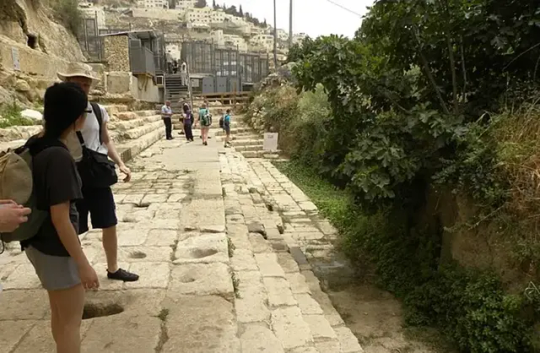
In recent weeks, archeologists achieved significant progress in the excavation, unearthing some eight steps descending into the Pool which had not been seen in 2,000 years — around the time when Jesus walked the Earth.
“The ongoing excavations within the City of David — the historic site of Biblical Jerusalem — particularly of the Pool of Siloam and the Pilgrimage Road, serve as one of the greatest affirmations of that heritage and the millennia-old bond Jews and Christians have with Jerusalem,” Ze’ev Orenstein, director of International Affairs – City of David Foundation said.
“Not simply as a matter of faith, but as a matter of fact,” he added.
The City of David Foundation is a non-profit organization established in 1986, “dedicated to the preservation and development of the City of David and its environs, and is committed to connecting people of all faiths and backgrounds to ancient Jerusalem.”
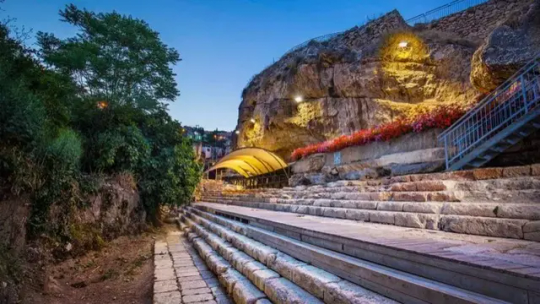
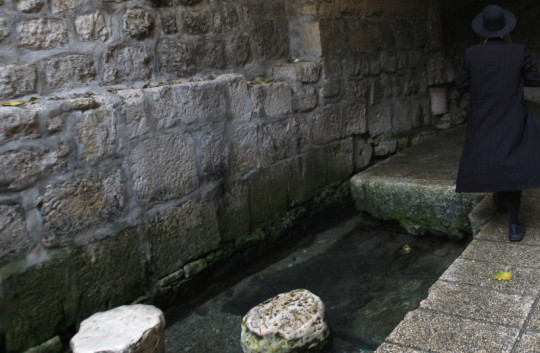
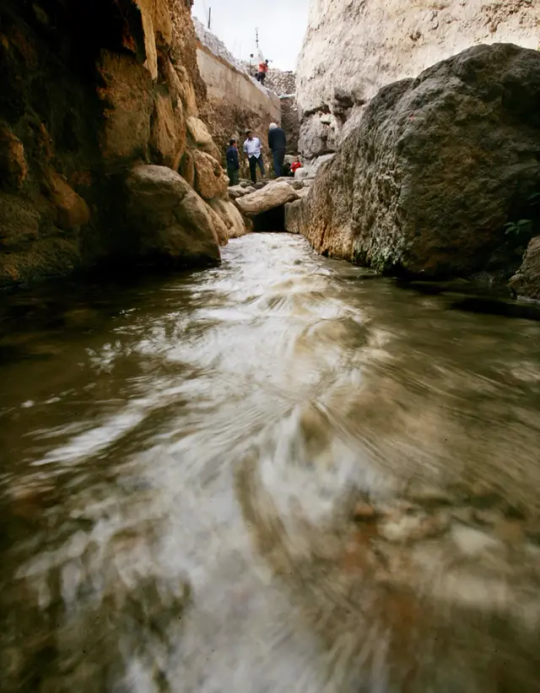
“The half-mile running through the City of David, from the Pool of Siloam in the south, continuing along the Pilgrimage Road, up to the footsteps of the Western Wall, Southern Steps and Temple Mount, represents the most significant half-mile on the planet,” Orenstein said.
“There is no half-mile anywhere on Earth which means more to more people – not to millions, but to billions — than the half-mile that is the City of David,” he added.
The pool was first built roughly 2,700 years ago as part of Jerusalem’s water system in the eighth century B.C.
The construction unfolded during the reign of King Hezekia as cited in the Bible in the Book of Kings II, 20:20, according to the two Israeli agencies and the City of David Foundation.
According to estimates, the Pool of Siloam passed through many stages of construction and reached the size of 1.25 acres.
According to a passage in the Gospel of John, Jesus restored the sight of a man born blind at the Pool of Siloam.
A small section of the pool, which has been fully excavated, has been accessible to the public for several years.
The vast majority of the pool is being excavated and will either be opened piecemeal or once the entire site is unearthed.
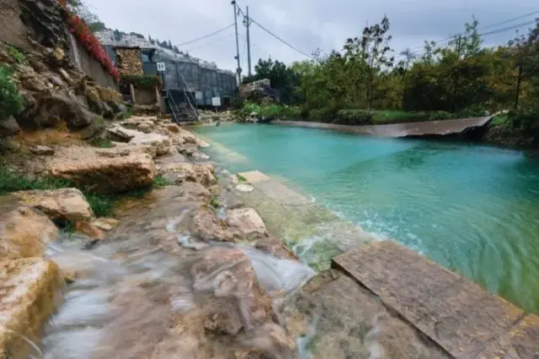
Rev. Johnnie Moore, president of the Congress of Christian Leaders, told Fox News Digital in January that, “In the Pool of Siloam, we find evidence of history preserved for us, revealed at just the right time.”
“Theologically, it affirms Scripture, geographically it affirms scripture, and politically it affirms Israel’s unquestionable and unrivaled link to Jerusalem. Some discoveries are theoretical. This one is an undeniable. It is proof of the story of the Bible and of its people, Israel,” he said.
A stroke of luck revealed the pool in 2004, when infrastructure work carried out by the Hagihon water company uncovered some of the pool’s steps.
The Israel Antiquities Authority, under supervision of professors Roni Reich and Eli Shukron, launched a survey.
As a result, the northern perimeter, as well as a small section of the eastern perimeter of the Pool of Siloam, were uncovered.
“Whether in the halls of the United Nations, ongoing efforts by Palestinian leadership, or on university campuses, Jerusalem’s Biblical heritage is under assault,” said Orenstein.
Orenstein noted that in few years time, visitors to the City of David will be able to witness the factual history for themselves and “see with their own eyes, touch with their own hands, and walk with their own feet upon the very stones their ancestors walked thousands of years ago, as they made their way to Jerusalem on pilgrimage.”
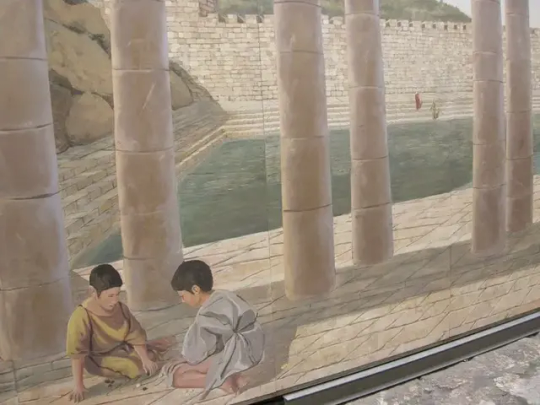
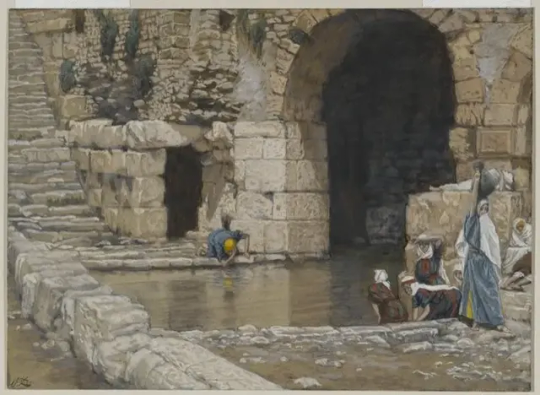

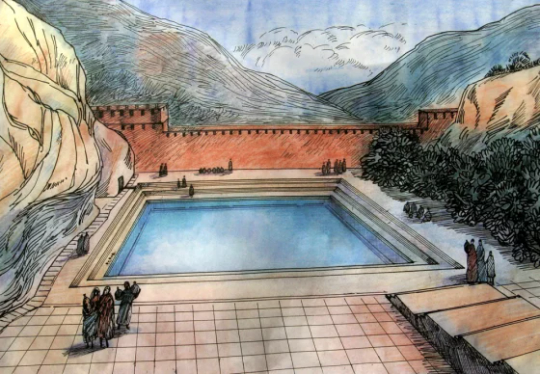
#Biblical Steps Where Jesus 'Healed a Blind Man' Unearthed by Archaeologists#Jerusalem#Israel#City of David#Pool of Siloam#Pilgrimage Road#King Hezekia#Jesus#Jesus Christ#ancient artifacts#archeology#archeolgst#history#history news#ancient history#ancient culture#ancient civilizations#ancient israel
130 notes
·
View notes
Text
The tunnel of Hezekiah.
Water tunnel carved under the City of David in Jerusalem in ancient times. Its popular name is due to the most common hypothesis of its origin, namely, that it dates from the reign of Hezekiah.
The tunnel leads from the Gihon Spring to the Pool of Siloam. If indeed built under Hezekiah, it dates to a time when Jerusalem was preparing for an impending siege by the Assyrians, led by Sennacherib.
Since the Gihon Spring was already protected by a massive tower and was included in the city's defensive wall system, Jerusalem seems to have been supplied with enough water in case of siege even without this tunnel. The curving tunnel is 533 m., According to the Siloam inscription, the tunnel was excavated by two teams, one starting at each end of the tunnel and then meeting in the middle.
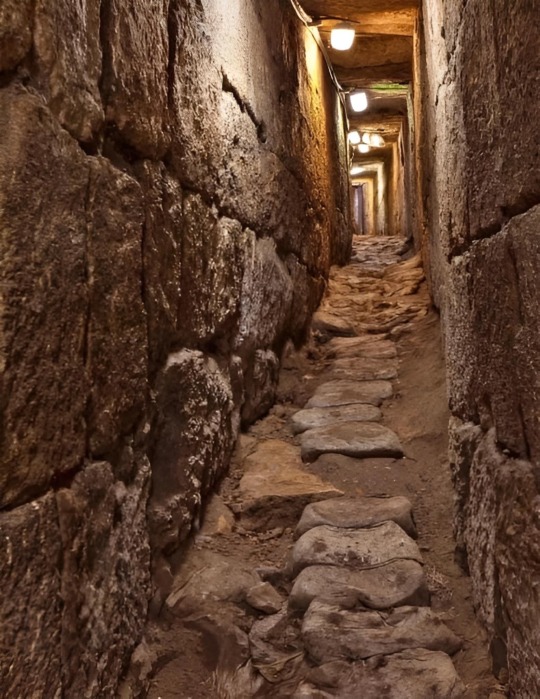
#jerusalem#israel#secular-jew#jewish#judaism#israeli#diaspora#secular jew#secularjew#islam#hezekiah#tunnels#kind David#pool of siloam#Assyrians
26 notes
·
View notes
Text
Biblical Archaeology Lesson 02: The New Testament
In our previous study, we examined ten archaeological discoveries that demonstrated the historical accuracy of the Old Testament. Today, we will examine ten archaeological finds with relevance to the New Testament.
Let’s read together Acts 13:6-12.
Sergius Paulus inscription
A Roman proconsul was a governor or military commander of a province. Sergius was the proconsul of Cyprus under the reign of Claudius Caesar from 45 to 50 AD. A stone with a Greek inscription dating to 54 AD was found in northern Cypress. The inscription referred to an event that happened earlier than 54 AD and referenced a “proconsul Paulus.” It is very likely this inscription is speaking of the same Sergius Paulus who encountered Paul the Apostle in Paphos.
Let’s read together John 9:1-7.
Pool of Siloam
The pool of Siloam was a freshwater reservoir in the time of Jesus. It was at this pool where Jesus miraculously cured a man of his blindness. It was accidentally discovered in 2004 by workers doing sewage pipe maintenance in the old city of Jerusalem. The discovery of the pool of Siloam shows that the book of John is not a purely theological book. Rather, it is grounded in history.
Let’s read together Acts 19:22; Romans 16:23; and 2 Timothy 4:20..
Erastus inscription
A stone with a Latin inscription dating around 50 AD was found in Corinth. The inscription translated in English reads: “Erastus in return for hisa aedileship laid (the pavement) at his own expense.” (An aedile was a Roman magistrate in charge of public works.) This discovery points to the historicity of Erastus, an evangelist and a socially elite individual mentioned by Paul the Apostle.
Let’s read together Matthew 26:3 and John 18:13-14.
Caiaphas ossuary
An ossuary with the engraving “Joseph son of Caiaphas” was discovered in a burial cave in the old city of Jerusalem. The skeletal remains inside the ossuary were of a 50 year old. This ossuary is very likely the remains of the priest who presided over the trial of Jesus.
Let’s read together Acts 21:27-30 and Ephesians 2:14.
Temple warning inscription
The Jewish historian Josephus wrote of a partition in the Jewish temple with a stone inscription forbidding foreigners from entering the temple upon penalty of death. A complete stone inscription with such a warning was found in Jerusalem in 1871. Interestingly, there were traces of red paint in the stone inscription, meaning it was meant to be very visible to people.
This inscription correlates with the story in Acts 21:28-30 where the Jews accused Paul of bringing in Greeks into the temple and defiling it. Paul may have also referred to this barrier in Ephesians 2:14.
Let’s read together Leviticus 23:24 and Matthew 24:1-2.
Trumpeting place inscription
A stone with the Hebrew inscription “to the place of trumpeting” was discovered in Jerusalem, dating to the first century. It is thought this stone was atop the southwest corner of the temple of Jerusalem before it was cast down. This is evidence for the existence of the second temple of Jerusalem, which was destroyed in 70 AD.
Let’s read together Matthew 28:11-13.
Nazareth inscription
This stone inscription contains an edict from Caesar proclaiming the death penalty for those caught stealing bodies from tombs. This is a rather unusual decree as grave robbers normally would steal items from tombs, but not the bodies.
It is quite possible this inscription was written by Claudius Caesar in response to hearing Christians sharing the story of Jesus’ resurrection. Claudius would have considered Christians a dangerous anti-Roman movement.
Let’s read together Acts 18:12.
Gallio inscription
This is a collection of nine stone fragments of a letter written by Claudius Caesar in 52 AD. The Gallio inscription was found in Delphi, Greece, which is about 50 miles northwest of Corinth. This inscription makes mention of Junius Gallio being proconsul of Achaia. Gallio only served as proconsul from 51 to 52 AD. The Gallio inscription is a fixed marker that allows us to date Paul’s ministry.
Let’s read together Matthew 27:1-24 and Mark 15:1-15.
Pilate stone
Pontius Pilate was a Roman prefect governing Judea from 26 to 34 AD. He is mentioned by the historians Josephus, Tacitus, and Philo in addition to the Gospels. The Pilate stone confirms the historicity of Pontius Pilate.
Let’s read together John 18:31-33.
P52 fragment of John 18:31-33
This is a papyrus fragment dating to 125 to 175 AD. This is the oldest known fragment of the New Testament Gospels. The significance of this fragment is that it was written within 100 years of the events of the Gospels.
There has not been an archaeological find that contradicts the Bible. The historical events recorded in the New Testament are factual. The archaeological discoveries mentioned in this lesson should increase our trust in the Bible.
Friend, will you trust what the Bible says about historical things? Will you trust what the Bible says about spiritual things?
5 notes
·
View notes
Text
Unearthing History: Steps Unseen for 2,000 Years Revealed at Site Where Jesus Healed
Exciting news from Jerusalem! A new excavation project has uncovered steps leading to the Pool of Siloam, a biblical site where Jesus healed a blind man. This significant discovery allows public access to the pool for the first time in two millennia. Join us as we explore this fascinating find and delve into the rich history of Jerusalem.
0 notes
Text
Gospel of John Chapter 9
When Chapter 8 ends they’re trying to stone Messiah which didn’t concern Him a bit, but He passed a man born sightless so stopped to interact with him. His disciples questioned why was he born blind, some neighbors didn’t even recognize him, so unneighborly and Pharisee’s only concerned about their senseless rules, only Jesus seemed focused on helping him see. Jesus answered His disciples about…
View On WordPress
0 notes
Text
Sunday School Live Stream - March 5, 2023
https://www.facebook.com/akronalliancefellowship/videos/565147962241018 Sunday school session with Asst. Pastor Melvin Gaines. John 9:1-12.
View On WordPress
#blind#blind from birth#conflict#darkness#disciple#faith#growing faith#heal#Jesus#John#John 9#light#Pool of Siloam#reach#religious#sent#sin#time
0 notes
Photo

Rustic Pool Denver Large rustic backyard hot tub with a rectangular shape as an idea
#buff flagstone#siloam slab wall#pool#landscape#washington cascade cedar mulch#patio#flagstone and cement patio
0 notes
Text




ooooo you want to come visit me soo bad 🌀🌀🌀🌀 you want to come swim in the pool of siloam soooo bad 🌀🌀🌀🌀

#😌#photo#my photo#landscape#nature#outdoors#waterfall#hiking#waterfalls#stairs#photography#original photography on tumblr#photographers on tumblr#pond#lake#river
21 notes
·
View notes
Text
365 Promises of God
Day 297 – Unless You Repent You Will Perish
I tell you, no; but unless you repent you will all likewise perish. (Luk 13:3 NKJV)
Read: Luke 13:1-5
Ever imagine Jesus giving a facepalm? I sure do. I bet I’ve given him plenty of reason to have one. And today’s reading is no different. Jesus had just finished in Ch12 giving a discourse on being faithful to those put over you. Then he goes on to tell them that he’d come to bring division. And asks why they can’t judge among themselves rather than bringing each other to court.

These things seem random, but they are all connected, as we will see in a moment. The question that was presented to Jesus at this point was about a group of Galileans who followed Judas Gaulonites. Their sect believed that they had no sovereign but God, and did not recognize Caesar as king, refusing to pay any tribute or tax. They went so far as to endure suffering and death rather than call any man Lord. These men had been slaughtered by Pilate INSIDE the temple, and their blood had defiled the blood of the sacrifice, turning it into an abomination.
To those standing around, this seemed to them an indication of God’s judgement. They perished, and their sins could NOT be forgiven, because their own blood defiled their own atoning sacrifices. Surely God was condemning these vile sinners to hell, as evidenced by this tragedy. And frankly, the Jews in Jerusalem often thought those backwards people living in Galilee were bigger sinners anyway. Maybe Jesus was just like them?
It’s probable that this exchange was initiated because Jesus had discussed His own lordship in Ch12, and Peter had even called Him Lord. In fact, this word, kyrios, appears NINE times in Ch12. Would this multitude surrounding him call Him Lord? Eh, no, they missed the point to stab at him.
The men Jesus was addressing had condemned their brothers on circumstantial evidence. They turned the knife, so to speak, by pointing out that they were ‘Galileans’. But Jesus answers their question with a ‘question answer’. “Do you think these ‘Galileans’ were bigger sinners than all the other ‘Galileans’ because of this?” Normally, a ‘question answer’ isn’t rhetorical. But Jesus supplies the answer FOR them, because it’s critically important.
NO! They weren’t worse sinners than any other Galileans. Away with your condemnation of others for their misfortunes. Instead, look in a mirror and consider your OWN soul. Unless you REPENT, you will all likewise perish. Sadly, this was a prophesy and a promise. Because this tragedy DID happen to many standing there, in AD70, when Titus invaded Jerusalem to quell an uprising, and slaughtered a multitude there inside the temple where they’d taken refuge.
Jesus doesn’t stop there, though. He asks another question, much closer to home, about a tower in Jerusalem, overlooking the Pool of Siloam, that fell on and crushed 18 people. These weren’t ‘Galileans’. They were your close neighbors. Yet some random tragedy, an act of God so to speak, had happened, and killed them all. Were they worse sinners than all of YOU?
Again, he doesn’t leave the question unanswered. Away with your bigotry about the Galileans. Away with your condemnation of others. Unless you repent, you will all likewise perish. And again, this is a prophesy that was fulfilled in AD70, when Rome, destroying Jerusalem, tore down towers, buildings, and walls, crushing the inhabitants of Jerusalem under the rubble.
Yet this sad promise doesn’t just pertain to the men standing there, does it? The statement Jesus makes here is critical for all of us to pay attention to. Hell is hot, and we are not. Unless WE repent, there’s outer darkness and weeping and wailing and gnashing of teeth and a lake of fire.
‘Repent’ is not a word we like. It indicates we’ve done something wrong. It tells us we are headed the wrong way, and need to turn around. Most of us would like to avoid that word. To pretend we are all ok, doing what we are doing, and that somebody else is the ‘bad guy’. But when we take a good hard look at the person in the mirror, we understand the truth. It’s only by His mercy and grace that we have any hope of avoiding the eternal ‘perish’ indicated here.
It's my prayer that this promise is NOT for any of us. But even if you, reading this right now, realize this promise is aimed at you, it begins with a sweet word. The word, UNLESS. The same word the Lorax left at the end of that Seuss classic, and it’s the same word left for you and me. That word gives us hope, that there’s a chance. A chance to avoid all that unpleasant eternal lake of fire. The judgement we deserve, but can avoid, through that simple word, repent.
This Greek word, metanoeo, is found 34 times in the New Testament, and each time translated ‘repent’. It means to turn around. Turn from sin to God. Agree with God that what you were doing was wrong. It’s so simple, yet so hard, sometimes. And everything depends on it.
Prayer:
Lord, thank you for another chance. You are always giving me second chances. Lord, I repent of what I’ve been doing that wasn’t right and good and pure. Help me to follow you with all my heart, today. Amen
#christian#devotional#365 devos#365 promises of god#booklr#writing#chris solaas#repentance#faith#salvation#jesus#christblr
7 notes
·
View notes
Text
𝐌𝐚𝐫𝐜𝐡 𝟏𝟎, 𝟐𝟎𝟐𝟒 𝐆𝐨𝐬𝐩𝐞𝐥
Fourth Sunday of Lent
Jn 9:1, 6-9, 13-17, 34-38
As Jesus passed by he saw a man blind from birth.
He spat on the ground and made clay with the saliva,
and smeared the clay on his eyes,
and said to him,
“Go wash in the Pool of Siloam” — which means Sent —.
So he went and washed, and came back able to see.
His neighbors and those who had seen him earlier as a beggar said,
“Isn’t this the one who used to sit and beg?”
Some said, “It is, “
but others said, “No, he just looks like him.”
He said, “I am.”
They brought the one who was once blind to the Pharisees.
Now Jesus had made clay and opened his eyes on a sabbath.
So then the Pharisees also asked him how he was able to see.
He said to them,
“He put clay on my eyes, and I washed, and now I can see.”
So some of the Pharisees said,
“This man is not from God,
because he does not keep the sabbath.”
But others said,
“How can a sinful man do such signs?���
And there was a division among them.
So they said to the blind man again,
“What do you have to say about him,
since he opened your eyes?”
He said, “He is a prophet.”
They answered and said to him,
“You were born totally in sin,
and are you trying to teach us?”
Then they threw him out.
When Jesus heard that they had thrown him out,
he found him and said, “Do you believe in the Son of Man?”
He answered and said,
“Who is he, sir, that I may believe in him?”
Jesus said to him,
“You have seen him, and
the one speaking with you is he.”
He said,
“I do believe, Lord,” and he worshiped him.

#jesus#catholic#my remnant army#jesus christ#virgin mary#faithoverfear#saints#jesusisgod#endtimes#artwork#Jesus is coming#come holy spirit#Gospel#word of God#Bible#bible verse of the day#bible verse
13 notes
·
View notes
Text

John 9:1-7 (ESV). “As he passed by, he saw a man blind from birth. And his disciples asked him, “Rabbi, who sinned, this man or his parents, that he was born blind?” Jesus answered, “It was not that this man sinned, or his parents, but that the works of God might be displayed in him. We must work the works of him who sent me while it is day; night is coming, when no one can work. As long as I am in the world, I am the light of the world.” Having said these things, he spit on the ground and made mud with the saliva. Then he anointed the man’s eyes with the mud and said to him, “Go, wash in the pool of Siloam” (which means Sent). So he went and washed and came back seeing.”
“Jesus Is Interruptible” by In Touch Ministries:
“Choose to see interruptions as opportunities to love like Jesus.”
“In our passage today, the Lord was on His way somewhere but stopped to heal a blind man. He could easily have passed by—Jesus was a busy man, after all. But He allowed Himself to be interrupted, and one person’s life was forever changed.
“I am the Light of the world,” Jesus said before applying mud to the man’s sightless eyes (v. 5). The thought of putting mud in a blind man’s eyes to clear his vision might seem strange to us today. However, Jewish onlookers may have recognized this as a medical practice of the day. It’s even possible they interpreted it as a new act of creation, since mud could have reminded them of God forming Adam from the dust of the earth. If such scriptural imagery was, in fact, Jesus’ intention, it would convey that He truly was the Word who was with God in the beginning—one with God Himself.
Whatever the reason for this unusual-sounding treatment, we know that dirt and saliva became holy instruments in Jesus’ healing hands. So let’s consider what God might be doing in our midst and pray for His direction as we seek to love others through our time and attention. It’s exciting to realize that if we’re willing to alter our plans, we may become vessels of His healing work.”
(Photo by Jack Sharp at Unsplash)
#john 9:1-7#god loves you#bible verses#bible truths#bible scriptures#bible quotes#bible study#studying the bible#the word of god#christian devotionals#daily devotions#bible#christian blog#god#belief in god#faith in god#jesus#belief in jesus#faith in jesus#christian prayer#christian life#christian living#christian faith#christian inspiration#christian encouragement#christian motivation#christianity#christian quotes#in touch ministries#keep the faith
9 notes
·
View notes
Text
The Israel Antiquities Authority, the Israel National Parks Authority and the City of David Foundation early this year announced that the Pool of Siloam, a biblical site cherished by Christians and Jews, will be open to the public for the first time in 2,000 years in the near future...
13 notes
·
View notes
Text
Saints &reading: Sunday, December 17, 2023
december 4_december 17
THE HOLY GREATMARTYR BARBARA (306)

The Holy Great-martyr Barbara lived and suffered during the reign of Emperor Maximian (305-311). Her father, a pagan named Dioscoros, was an eminent, wealthy man who lived in the town of Heliopolis in Phoenicia. Widowed early in life, he focused all of his devotion upon his only daughter. Seeing Barbara’s extraordinary beauty, Dioscoros decided to raise her out of the sight of others. To this end, he erected a tower in which only Barbara and her pagan teachers dwelt. Below the tower was spread out the length and breadth of God’s world. During the day, one could view the wooded hills, the fast-flowing rivers, and the plains, carpeted with flowers. At night, a great sea of lights presented sights of inexpressible beauty. Soon the maiden began to ask herself about the Creator and the reason behind such a harmonious and marvelous world. Gradually, she came to the firm conclusion that the lifeless idols which her father and her teachers worshipped were works of human hands, incapable of having so wisely and marvelously ordered the world around her. The desire to know the Truth of God so gripped Barbara’s soul that she decided to devote her life to it, and to spend her life in virginity.
Her beauty gained renown throughout the city, and many sought her hand. However, despite her father’s loving entreaties, she refused to marry. Barbara warned her father that his insistence might result in tragedy, separating them forever. Dioscoros decided that life in isolation had affected his daughter’s character. He allowed her to leave the tower, and allowed her total freedom in choosing her friends and acquaintances. In the city, the maiden met young confessors of the Christian Faith who taught her about the Divine Logos, Creator of the world. Some time later, by God’s Providence, a priest disguised as a merchant came to Heliopolis. He performed the rite of Holy Baptism over Barbara.
At that time, Dioscoros was having a large bathhouse built at his home. He left instructions that two windows be installed on the South side. However, in her father’s absence, Barbara arranged to have the workers install a third window, to create an image of the Triune Light. Over the entrance to the bathhouse, where Barbara described the outline of a Cross, the image became firmly impressed on the stone. A spring burst forth from the place where her footprints had landed on the steps of the bathhouse. Later it manifested great healing powers.
In his account of the holy martyr’s sufferings, Symeon Metaphrastes compared the spring to the life-giving power of the Jordan and the pool of Siloam. When Dioscoros returned and expressed dissatisfaction with the alterations made to the plan of construction, his daughter related to him her coming to know the Triune God, the salvific power of the Son of God, and the futility of idol worship. Dioscoros became angry, and unsheathed his sword to strike her. The maiden ran from her father, and he followed in pursuit. A fissure in a mountain along the way opened to hide the saint. At its other end, an opening led upward. St. Barbara managed to hide in a cave on the other side of the mountain. After a long and fruitless search for his daughter, Dioscoros saw two shepherds on the mountainside. One of them showed him the cave in which the saint had hidden herself. Dioscoros cruelly beat his daughter, locked her up under guard, and for a long time tortured her with hunger. Finally, he handed her over to Markianos, governor of the city. St. Barbara was cruelly tortured. They flogged her with rawhide whips, and abraded her wounds with a coarse hair cloth. At night, the Lord Himself visited the fervently praying saint in prison, and tended to her wounds. Later, the saint was subjected to new, even more cruel trials.
Juliana, a resident of Heliopolis and a Christian, was standing in the crowd near the place of the saint’s torture. Witnessing the beautiful and renowned maiden’s voluntary martyrdom, her heart overflowed with compassion. Wanting to suffer for Christ as well, she began to loudly denounce the torturers. She was taken. The holy martyrs were subjected to lengthy trials: Their flesh was ripped with iron hooks, their breasts were severed, and they were led naked throughout the city, to be subjected to ridicule and beatings. Heeding St. Barbara’s prayers, the Lord sent an angel, who covered the naked saints with glistening garments. Resolute confessors of the Christian Faith, Sts. Barbara and Juliana were beheaded. Dioscoros himself put Barbara to death. God’s retribution fell quickly upon Markianos and Dioscoros; both were consumed by lightning.
In the 6th Century, the relics of the Saint were translated to Constantinople. In the 12th Century, Princess Barbara, daughter of the Byzantine Emperor Alexis Comnenos (1081-1118) married the Russian Prince Michael Izyaslavitch, and brought the relics with her to Kiev. They rest in the Cathedral of St. Vladimir to this day.
Source: Russion Orthodox Cathedral of St John the baptist
St JOHN DAMASCENE (760)

Saint John of Damascus was born about the year 680 at Damascus, Syria into a Christian family. His father, Sergius Mansur, was a treasurer at the court of the Caliph. John had also a foster brother, the orphaned child Cosmas (October 14), whom Sergius had taken into his own home. When the children were growing up, Sergius saw that they received a good education. At the Damascus slave market he ransomed the learned monk Cosmas of Calabria from captivity and entrusted to him the teaching of his children. The boys displayed uncommon ability and readily mastered their courses of the secular and spiritual sciences. After the death of his father, John occupied ministerial posts at court and became the city prefect.
In Constantinople at that time, the heresy of Iconoclasm had arisen and quickly spread, supported by the emperor Leo III the Isaurian (717-741). Rising up in defense of the Orthodox veneration of icons [Iconodoulia], Saint John wrote three treatises entitled, “Against Those who Revile the Holy Icons.” The wise and God-inspired writings of Saint John enraged the emperor. But since the author was not a Byzantine subject, the emperor was unable to lock him up in prison, or to execute him. The emperor then resorted to slander. A forged letter to the emperor was produced, supposedly from John, in which the Damascus official was supposed to have offered his help to Leo in conquering the Syrian capital.
This letter and another hypocritically flattering note were sent to the Saracen Caliph by Leo the Isaurian. The Caliph immediately ordered that Saint John be removed from his post, that his right hand be cut off, and that he be led through the city in chains.
That same evening, they returned the severed hand to Saint John. The saint pressed it to his wrist and prayed to the Most Holy Theotokos to heal him so that he could defend the Orthodox Faith and write once again in praise of the Most Pure Virgin and Her Son. After a time, he fell asleep before the icon of the Mother of God. He heard Her voice telling him that he had been healed, and commanding him to toil unceasingly with his restored hand. Upon awakening, he found that his hand had been attached to his arm once more. Only a small red mark around his wrist remained as a sign of the miracle.
Later, in thanksgiving for being healed, Saint John had a silver model of his hand attached to the icon, which became known as “Of the Three Hands.” Some unlearned painters have given the Mother of God three hands instead of depicting the silver model of Saint John’s hand. The Icon “Of the Three Hands” is commemorated on June 28 and July 12.
When he learned of the miracle, which demonstrated John’s innocence, the Caliph asked his forgiveness and wanted to restore him to his former office, but the saint refused. He gave away his riches to the poor, and went to Jerusalem with his stepbrother and fellow-student, Cosmas. There he entered the monastery of Saint Savva the Sanctified as a simple novice.
It was not easy for him to find a spiritual guide, because all the monks were daunted by his great learning and by his former rank. Only one very experienced Elder, who had the skill to foster the spirit of obedience and humility in a student, would consent to do this. The Elder forbade John to do anything at all according to his own will. He also instructed him to offer to God all his labors and supplications as a perfect sacrifice, and to shed tears which would wash away the sins of his former life.
Once, he sent the novice to Damascus to sell baskets made at the monastery, and commanded him to sell them at a certain inflated price, far above their actual value. He undertook the long journey under the searing sun, dressed in rags. No one in the city recognized the former official of Damascus, for his appearance had been changed by prolonged fasting and ascetic labors. However, Saint John was recognized by his former house steward, who bought all the baskets at the asking price, showing compassion on him for his apparent poverty.
One of the monks happened to die, and his brother begged Saint John to compose something consoling for the burial service. Saint John refused for a long time, but out of pity he yielded to the petition of the grief-stricken monk, and wrote his renowned funeral troparia (“What earthly delight,” “All human vanity,” and others). For this disobedience the Elder banished him from his cell. John fell at his feet and asked to be forgiven, but the Elder remained unyielding. All the monks began to plead for him to allow John to return, but he refused. Then one of the monks asked the Elder to impose a penance on John, and to forgive him if he fulfilled it. The Elder said, “If John wishes to be forgiven, let him wash out all the chamber pots in the lavra, and clean the monastery latrines with his bare hands.”
John rejoiced and eagerly ran to accomplish his shameful task. After a certain while, the Elder was commanded in a vision by the All-Pure and Most Holy Theotokos to allow Saint John to write again. When the Patriarch of Jerusalem heard of Saint John, he ordained him priest and made him a preacher at his cathedral. But Saint John soon returned to the Lavra of Saint Savva, where he spent the rest of his life writing spiritual books and church hymns. He left the monastery only to denounce the iconoclasts at the Constantinople Council of 754. They subjected him to imprisonment and torture, but he endured everything, and through the mercy of God he remained alive. He died in about the year 780, more than 100 years old.
Saint John of Damascus was a theologian and a zealous defender of Orthodoxy. His most important book is the Fount of Knowledge. The third section of this work, “On the Orthodox Faith,” is a summary of Orthodox doctrine and a refutation of heresy. Since he was known as a hymnographer, we pray to Saint John for help in the study of church singing.
Source: Orthodox Church in America_OCA


LUKE 24:36-53
36 Now as they said these things, Jesus Himself stood in the midst of them, and said to them, "Peace to you." 37 But they were terrified and frightened, and supposed they had seen a spirit. 38 And He said to them, "Why are you troubled? And why do doubts arise in your hearts? 39 Behold My hands and My feet, that it is I Myself. Handle Me and see, for a spirit does not have flesh and bones as you see I have. 40 When He had said this, He showed them His hands and His feet. 41 But while they still did not believe for joy, and marveled, He said to them, "Have you any food here?" 42 So they gave Him a piece of a broiled fish and some honeycomb. 43 And He took it and ate in their presence. 44 Then He said to them, "These are the words which I spoke to you while I was still with you, that all things must be fulfilled which were written in the Law of Moses and the Prophets and the Psalms concerning Me." 45 And He opened their understanding, that they might comprehend the Scriptures. 46 Then He said to them, "Thus it is written, and thus it was necessary for the Christ to suffer and to rise from the dead the third day, 47 and that repentance and remission of sins should be preached in His name to all nations, beginning at Jerusalem. 48 And you are witnesses of these things. 49 Behold, I send the Promise of My Father upon you; but tarry in the city of Jerusalem until you are endued with power from on high. 50 And He led them out as far as Bethany, and He lifted up His hands and blessed them. 51 Now it came to pass, while He blessed them, that He was parted from them and carried up into heaven. 52 And they worshiped Him, and returned to Jerusalem with great joy, 53 and were continually in the temple praising and blessing God. Amen.
LUKE 24:36-53
36 Now as they said these things, Jesus Himself stood in the midst of them, and said to them, "Peace to you." 37 But they were terrified and frightened, and supposed they had seen a spirit. 38 And He said to them, "Why are you troubled? And why do doubts arise in your hearts? 39 Behold My hands and My feet, that it is I Myself. Handle Me and see, for a spirit does not have flesh and bones as you see I have. 40 When He had said this, He showed them His hands and His feet. 41 But while they still did not believe for joy, and marveled, He said to them, "Have you any food here?" 42 So they gave Him a piece of a broiled fish and some honeycomb. 43 And He took it and ate in their presence. 44 Then He said to them, "These are the words which I spoke to you while I was still with you, that all things must be fulfilled which were written in the Law of Moses and the Prophets and the Psalms concerning Me." 45 And He opened their understanding, that they might comprehend the Scriptures. 46 Then He said to them, "Thus it is written, and thus it was necessary for the Christ to suffer and to rise from the dead the third day, 47 and that repentance and remission of sins should be preached in His name to all nations, beginning at Jerusalem. 48 And you are witnesses of these things. 49 Behold, I send the Promise of My Father upon you; but tarry in the city of Jerusalem until you are endued with power from on high. 50 And He led them out as far as Bethany, and He lifted up His hands and blessed them. 51 Now it came to pass, while He blessed them, that He was parted from them and carried up into heaven. 52 And they worshiped Him, and returned to Jerusalem with great joy, 53 and were continually in the temple praising and blessing God. Amen
#orthodoxy#orthodoxchristianity#easternorthodoxchurch#originofchristianity#spirituality#holyscriptures#bible#gospel#wisdom#saints
6 notes
·
View notes
Text
Live Stream Sunday School - March 5, 2023
https://www.facebook.com/gaines.melvin/videos/604771777707409 Sunday school session for Akron Alliance Fellowship Church, Akron OH. John 9:1-12.
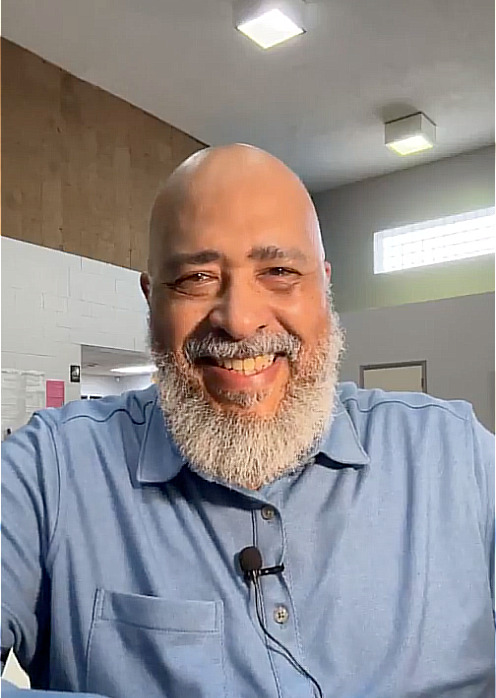
View On WordPress
#blind#blind from birth#conflict#darkness#disciple#faith#growing faith#heal#Jesus#John#John 9#light#Pool of Siloam#reach#religious#sent#sin#time
0 notes
Text
Unveiling the Ancient Marvel: Exploring the Map of Uruk City
In the realm of biblical archaeology, few discoveries evoke as much fascination and scholarly inquiry as the map of Uruk City. Situated in Mesopotamia, this ancient city stands as a testament to the ingenuity and complexity of early urban civilizations. The map of Uruk provides a glimpse into the layout and organization of one of the world's earliest cities, offering invaluable insights into the social, economic, and religious dynamics of its inhabitants.
At the heart of the Uruk map lies a rich tapestry of intersecting streets, bustling marketplaces, and monumental structures. Mount Ebal map and Mount Seir map stand as prominent landmarks, each imbued with cultural and religious significance. These elevated points not only provided strategic vantage points for defense but also served as focal points for rituals and ceremonies, connecting the earthly realm with the divine.
Venturing beyond the city limits, the map reveals the intricate network of trade routes that connected Uruk with distant lands. From the fertile plains of Moab to the bustling markets of distant city-states, Uruk's influence extended far beyond its walls. The depiction of the Plains of Moab map underscores the city's economic prowess and its role as a hub of commerce and cultural exchange.
One of the most striking features of the Uruk map is the meticulous representation of its hydraulic infrastructure. The intricate system of canals, reservoirs, and irrigation channels facilitated agricultural productivity and sustained the city's burgeoning population. At the heart of this hydraulic network lies the iconic Pool of Siloam map, a vital source of water and a symbol of life and renewal for the inhabitants of Uruk.
However, the significance of the Uruk map extends beyond its practical utility. It serves as a tangible link to the past, offering a window into the daily lives and beliefs of ancient Mesopotamians. Through careful analysis of the map's symbols and inscriptions, archaeologists have pieced together a nuanced understanding of Uruk's religious practices, political structures, and social hierarchies.
In conclusion, the map of Uruk City stands as a remarkable testament to the achievements of ancient civilizations. Its intricate details and symbolic representations offer a glimpse into a bygone era, allowing us to unravel the mysteries of the past. By studying the map of Uruk, we gain not only a deeper appreciation for the ingenuity of our ancestors but also valuable insights into the complexities of urban life in antiquity.
Source Url: https://biblicalarchaeology1.blogspot.com/2024/05/unveiling-ancient-landscape-exploring_17.html
0 notes
Note
On Twitter I came across a debate where someone was criticizing Israelis for displacing Palestinians in Jerusalem to chase after "Biblical myths" (which actually is a serious issue, although the specific thing they were criticizing Israel for looking for is the Pool of Siloam, which apparently was discovered by accident by municipal workers back in 2004) and that Jerusalem was founded by the Jebusite tribe of Canaanites (with the implication that the Palestinians were Canaanites). When some people pointed out that the Hebrews were themselves also Canaanites (as I understand it the current historical theory is that the Hebrews were a group of Canaanite tribes who went from being polytheists to thinking that their specific tribal God was the only God to exist, who then merged into one group due to external pressure from polytheist Canaanites, Egyptians, and Sumerians), someone else pointed out that the story of Abraham and Sarah meant that the Hebrews were immigrants from Ur, and I was like "wait, now you're saying that the Bible is a reliable historical source?" (again as I understand it, the story of Abraham and Sarah is a relic of the northern proto-Hebrews being within the Sumerian sphere of influence, while the story of the Exodus is due to the southern proto-Hebrews being within the Egyptian sphere of influence).
There's no intellectually honest, good-faith way for people to admit the Bible as evidence for Middle Eastern land ownership but then say the Jews are colonizers. Reasonable people cannot reasonably disagree on that. And that's not even touching on the absurd revisionism of "Palestinians as Canaanites," a favorite slogan of Saeb Erakat, whose family immigrated from Saudi Arabia in the 20th century.
21 notes
·
View notes